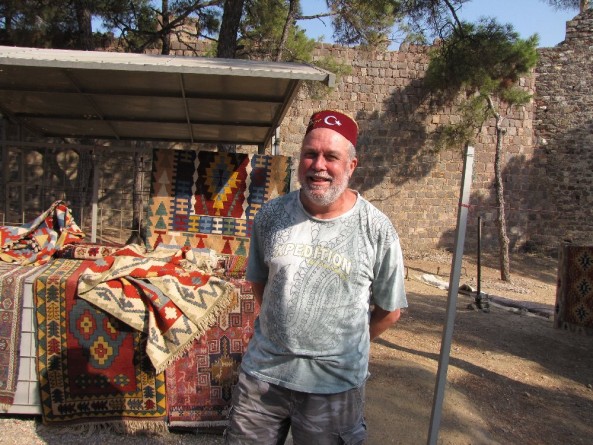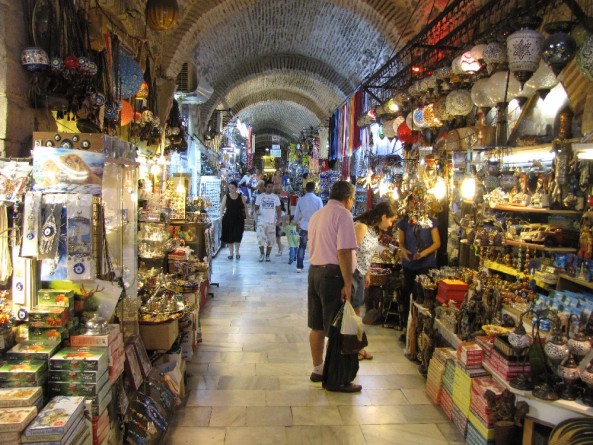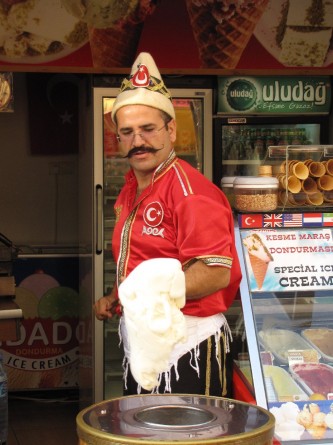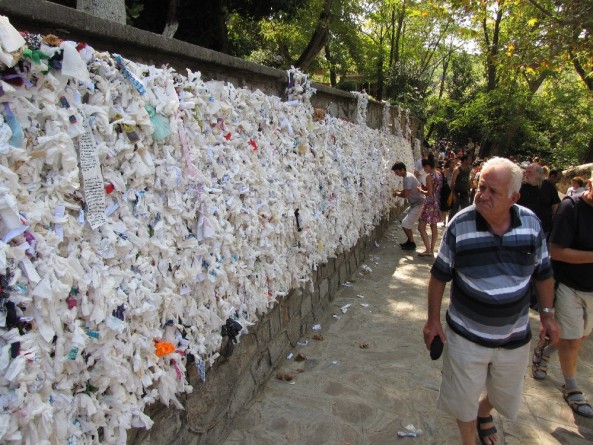If it’s Monday, this must be Izmir, a major tourist gateway on the Aegean coast to the beach resorts of Turkey (read: Why Turkey Should be on your Bucket List) and major attractions like the ruined city of Ephesus, the ancient capital of Asia Minor. I’m excited to be visiting Izmir for the first time, as it has an amazing history which stretches back 8000 years – it’s the birthplace of Homer and some of the oldest churches founded by St Paul. Today Izmir is a bustling modern city famous for its bazaars, with a 2000 year-old Roman agora (market).
After a media tour of Izmir on a very hot day, we are welcomed by local dignitaries like the mayor, governor and councillors over a formal lunch. Feeling seriously under-dressed I end up posing with other South African journos for an official photograph for the local newspaper in shorts, sandals and t-shirt! We also visit the atmospheric ruins of the castle of Alexander the Great on Mount Pagus – where the great general fell asleep and dreamed of building the city of Izmir which now lies at our feet.
Our charming guide tells us that Izmir was founded by an ancient warrior race of Amazonian women who cut off one breast so they could shoot a bow and arrow (I’m glad this is no longer the practice!). She says the original settlement was called Smyrna after a legendary Amazonian princess. At the castle souk I buy a red Turkish fez and pose for snapshots feeling ridiculously touristy. Arts and crafts are really cheap in Turkey – but try to barter the hawkers down to two-thirds of the original asking price. I pay around ten Turkish lira (R40) for a colourful handmade shoulder bag – and fifty lira (R200) for a handmade rug woven on a rainbow loom at the souk.

When in Izmir you also have to go shopping in the old Kemeralti souk; an ancient covered bazaar with arched stone ceilings – the silk road from the far east ended here. The souk is made up of a dozen special bazaars like the chestnut, goldsmith, glass (this is the place to buy those fantastical kaleidoscope coloured lamps), spice, fish, olive, nut and curio bazaars. We eat ripe purple figs for a few lira – one of Smyrna’s famous organic products, along with almonds, apricots and olives.

The ancient covered spice and silk marketplace in Izmir
We dine at one of the charming balik (fish) kitchens run by the local fishermen and their wives along the piers on the Incaralti promenade. It’s a delightfully rustic affair – perhaps eight chairs to every open-air family kitchen – on a wobbly pier right next to the fishing boats. For a bargain five Turkish lira (R20), we enjoy one of the best meals in Turkey – a plate of fried whiting fresh out the net, with salad, peppers and bread. Apart from waiters no-one speaks much English – so we point to what we want to eat.
We quaff bottles of Efes (named after the ruined city of Ephesus) – good Turkish pilsner – and tuck ravenously into kofte (the famous spicy lamb meatballs of Izmir) and pide, a doughy Turkish bread stuffed with spicy mince and peppers. For cheap street eats, watch out for cafes serving a spicy salami, cheese and tomato kumrucu or spinach and cheese pie, or beachfront stalls serving steamed mussels and corn on the cob. Don’t miss dondurmasi, a specialty ice-cream made from goat’s milk and syrup.

Making dondurmasi, the speciality ice-cream of Turkey
I really enjoy the ritual of drinking coffee in Turkey. Coffee came from the Middle East to Turkey in the middle ages, before being spread from here into Europe. The waiter tells me a local proverb, “A cup of coffee guarantees forty years of friendship” – so I drink plenty to make new friends! Turkish coffee is made by mixing extremely finely ground coffee with water and sugar. Don’t drink the sediment at the bottom of every cup! You have to tell the waiter how you like your espresso – sade (without sugar), az sekerli (a little sugar), orta (medium) or sekerli (a lot). Man they make strong coffee.
Today we go south from Izmir to Selcuk, gateway to the great Roman ruins of Ephesus – one of the great capitals of the ancient world, and a cradle of civilization in the Mediterranean. We join the pilgrims at the House of the Virgin May, a shrine (and major tourist attraction) on Bulbul Mt above Ephesus on the west coast of Turkey.
Our guide says Mary accompanied St John to Ephesus – and Pope John Paul II even visited the sixth century chapel. Walking in the silent footsteps of all the pilgrims, we light candles, offer prayers, make wishes at the wishing wall, and collect holy water from a spring. Amazingly, the house was only discovered in 1891 when a woman living in Germany who had never been to Ephesus had visions which led to the discovery of the shrine. It’s a very peaceful place today, set in a grotto of olive trees.

The wall of healing prayers at the shrine of St John, above Ephesus
Women once ruled in this part of the world – from the Amazonians to Mary to the ancient cult of Artemis, the virgin goddess of fertility. Sadly only a single mighty column is left of the Temple of Artemis, one of the seven wonders of the ancient world. But coming across the ruins of the mighty city of Ephesus for the first time takes my breath away. It’s a must-see on any Turkish itinerary, and rivals the ancient ruins of Athens or Rome. Over 200 000 inhabitants lived in the first city in the world to have street lamps lit by olive oil – during its golden age under Alexander the Great.
A word of advice: unless you’re a student of the classics, joining a tour is essential – like the old man told us at the entrance, “The stones don’t talk. You need a guide to understand Ephesus”. We’d brought along our own guide who explained how the great city was abandoned in the sixth century AD when the river silted up, and was left buried for almost two thousand years until archaeologists began excavating Ephesus in the nineteenth century – putting together “the biggest jigsaw puzzle in the world”. I was fascinated to see teams of archaeologists sorting through the fragments of stone.
We jostled with the tourist throng, like a vast Roman crowd of extras, down a marble road cut with deep chariot ruts. Through a valley of Indiana Jones ruins we passed temples, terraces, villas (you need an extra ticket to the terraces: make sure you book ahead and don’t miss the amazing mosaics), a vast gymnasium and agora. At the apothecary, the Roman inscription above the door forbids anyone from dying here and ruining the reputation of the hospital! The massive amphitheatre carved into the sides of the mountain holds 24 000 people and is still used for live concerts today. When Metallica started a concert in the amphitheatre, the columns started shaking – and the gig was cancelled!
We had a good laugh at the communal Roman lavatory with its row of hard loo seats carved into the stone over the long drops! Did you know the Romans invented the phrase “You’ve got the wrong end of the stick”? The sticks were used for ablutions! I’m told they also invented the terms “Life begins at forty” and “One for the road” in their wine bars – before driving off in their chariots. The highlight of our tour was the Library of Celsus – the world-famous icon of Ephesus with its three-tiered marble façade, busts, statues and stone shelves where one of the world’s greatest ancient collections of manuscripts was stored (like the library of Alexandria in Egypt).
We end up in Kusadasi, a tourist resort on the Aegean coast – and southern gateway to Ephesus. Kusadasi means bird island – after an offshore islet called Pigeon Island which is home to an old Genoese castle worth visiting. We strolled around one last souk and visited the quaint seaside resorts of Cesme (meaning fountain – a resort famous for its hot springs since Roman times) and Alacati nearby – where visitors have enjoyed the sun, surf and baths since antiquity. Daytripping around Turkey, we spent our last day out fishing and swimming on a dreamy yacht cruise along the Aegean coast from Cesme, the westernmost point in Turkey. It was time to move on to the Mediterranean.
Graham Howe was a guest of Turkish Airlines , Izmir Convention & Visitors Bureau and Izmir tourism agency.
You may also like
Related Posts
With the nickname 'Jewel of the Pacific' you'd expect Valparaíso to be a sparkling kind...
read more
Most visitors to Vietnam will arrive in Saigon first. Instead of rushing off elsewhere, linger...
read more
Andrew Thompson explains how South Africans can enjoy the beauty of Switzerland without completely blowing...
read more